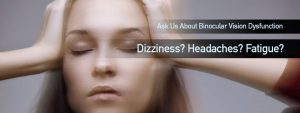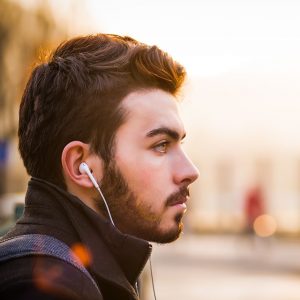Binocular Vision Dysfunction (BVD) is a condition where the eyes are slightly misaligned and the eyes struggle to send one clear image to the brain.
BVD can cause a variety of symptoms such as dizziness, motion sickness, headache, and light sensitivity.
BVD can significantly impact the lives of both children and adults and since there is a wide range of symptoms to BVD, this condition is often misdiagnosed as dyslexia or ADD/ADHD.
Symptoms of BVD
BVD symptoms can interfere with a person’s ability to function on a day-to-day basis. Doing basic tasks, such as driving a car or reading, can become difficult, due to motion sickness and results in life-changing anxiety and disorientation.
BVD can severely negatively impact the quality of life.
The list of symptoms of BVD can feel endless. Eye doctors sometimes categorized them to make it a bit easier to understand. The following symptoms are experienced by many BVD patients;
Physical Findings:
- Aches in neck and/or shoulder and back pain
- Moves over to left or right side when walking
- Knocks into shelves when walking down the aisle
- Tilts head
- Falls too often
- Dizzy spells
- Feeing feint
- Motion sickness
- Nausea
- Cheeks/sinus area feels uncomfortable
Visual Symptoms:
- Vision appears blurry
- Reading or computer are difficult to see clearly
- Sees haloes or glare during night
- Dim lighting blurry, eg restaurant menu or theatre
- Light sensitivity
- Eye strain at office or during school
- Frequent headaches or migraines
- When moving eyes experiences pain
Reading:
- Tiredness when reading
- Attention difficulties
- Loses concentration
- Easily distracted in classroom
- Reduced comprehension or reading fluency
- Skip over words or misses lines
- Words seem to ‘float’ or merge together
- Uses finger-pointing when reading
Binocular Vision Symptoms:
- Diplopia, or double vision
- Poor stereo vision or judging distances
- Difficulties with body-hand-eye coordination
- Squints, tils head or closes one eye
Driving Symptoms:
- Difficulties driving at night or in low light
- Avoids driving due to anxiety
- Loses confidence in accurately judging distances
Anxiety Symptoms:
- Heightened levels of anxiety
- Panic attacks in crowded areas
- Agoraphobia, dislike of open or unfamiliar areas
If you experience any of the symptoms listed above, contact an eye doctor near you that may be able to help diagnose and discuss treatment options for BVD.
SEE RELATED: Micro-prisms and BVD
Can BVD be misdiagnosed?
Yes, since BVD symptoms can mimic other conditions, this condition is frequently misdiagnosed.
Patients with BVD are often told they may have one of the following conditions, when in fact it could be BVD:
- Migraines
- Reading & learning disabilities
- Dyslexia
- ADD/ADHD
- Chronic fatigue Syndrome
- Agoraphobia and other anxiety/panic disorders
- Spinal or neck misalignment
- Meniere’s Disease
- BPPV (Benign Paroxysmal Positional Vertigo)
- PPPD (Persistent Postural-Perceptual Dizziness)
- MAV (Migraine Associated Vertigo)
- TMJ (temporomandibular joint) disorders
Treatment of BVD
While BVD is often misdiagnosed, once you have the right diagnosis there are treatment options that can eliminate the symptoms of binocular vision dysfunction.
BVD is successfully treated with specific optical lenses called ‘prism lenses’ and vision therapy.
Prism Lenses
Prismatic lenses work to correct the misalignment in your eyes by manipulating incoming light before it enters your eyes so that when the images from the two eyes reach the brain, the brain can fuse them into a single image.
The prisms in the glasses ‘trick’ the brain into thinking your eyes are properly aligned, causing you to see just one object and preventing eye muscle strain.
Vision Therapy
Patients with BVD are also often treated with a customized program of vision therapy. especially if suffering with dizziness.
Vision therapy is a program to improve the communication between the brain and the eyes, further supporting the visual system and alleviating the symptoms of BVD.
Usually, patients find that their symptoms gradually subside or completely disappear when they wear prescribed prism lenses, which can be even further helped by completing a program of vision therapy.
LEARN MORE: Guide to Binocular Visual Dysfunction (BVD)
An eye doctor experienced in BVD can discuss the treatment options to help you effectively maximize your vision allowing you to get back to enjoying life to the max.









